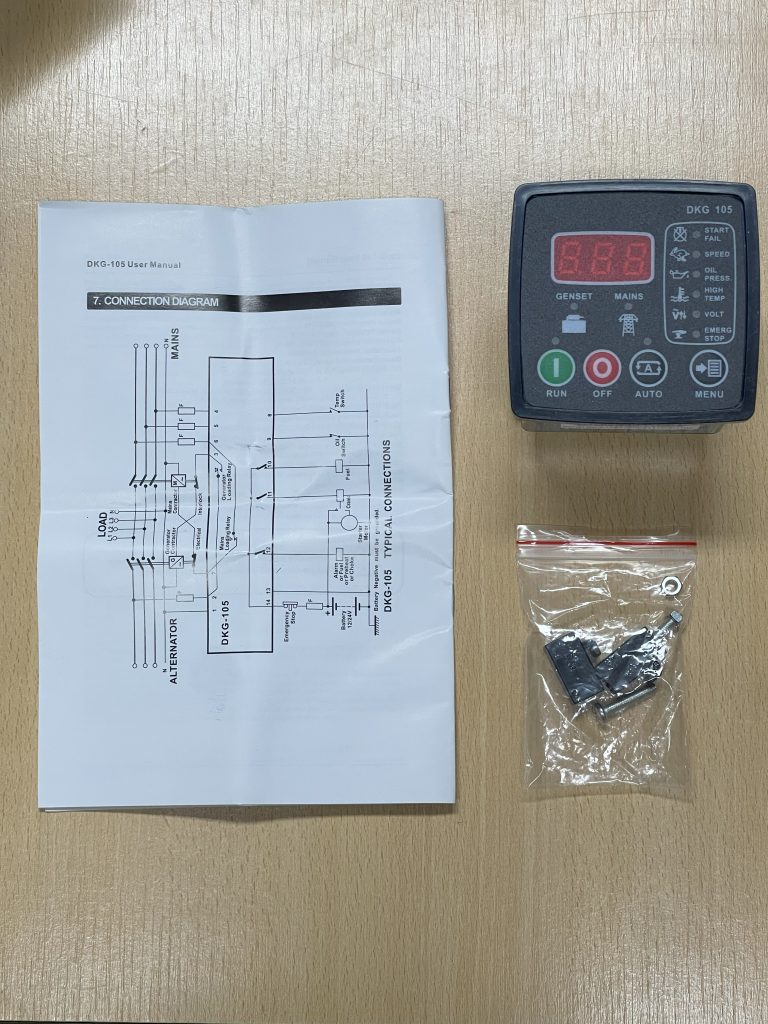As someone who has recently integrated the Datakom DKG-105 Automatic Mains Failure (AMF) Control Panel into my generator system, I aim to provide a detailed account of my experience, highlighting both the strengths and areas where the product could improve.
First Impressions and Installation
Upon receiving the DKG-105, I was immediately struck by its compact design. The unit fits seamlessly into a standard 72x72mm panel meter opening, which is a significant advantage for setups with limited space. The build quality appeared robust, and the materials used seemed durable, suggesting longevity.
The installation process was straightforward. The plug-in connection system facilitated easy integration, and the user manual provided clear instructions. However, I did notice that the manual could benefit from more detailed diagrams to assist those who might not be as familiar with electrical installations. Nonetheless, with some basic technical knowledge, setting up the unit was manageable.

Features and Functionality

The DKG-105 boasts a range of features designed to enhance generator management:
Fault Detection and Alerts: The DKG-105 is equipped to detect various fault conditions, such as over-speed or under-speed scenarios, and shuts down the generator to prevent potential damage. The unit’s alarm system promptly notifies users of any irregularities, allowing for swift corrective actions.
Automatic Engine Control: The unit efficiently manages the automatic starting and stopping of the engine. In the event of a mains failure, the DKG-105 promptly initiates the generator, ensuring minimal disruption. This feature has been particularly beneficial during unexpected power outages.
Mains and Generator Monitoring: It continuously monitors the voltages of both the mains and the generator. The digital display provides real-time readings, allowing for immediate assessment of the system’s status. I found this especially useful for ensuring that the generator operates within safe voltage limits.
Adjustable Parameters: One of the standout features is the ability to adjust timers and voltage thresholds digitally. This customization ensures that the generator operates optimally based on specific requirements. For instance, I was able to set precise voltage limits to match the sensitivity of my equipment.
Performance in Real-World Scenarios
In practical use, the DKG-105 has proven to be reliable. During a recent storm-induced power outage, the unit detected the mains failure and activated the generator within seconds. The transition was smooth, and there was no noticeable interruption to the power supply. This responsiveness is crucial, especially in environments where continuous power is essential.
The unit’s ability to handle cranking dropouts ensures that transient issues during startup do not lead to system failures. This resilience adds a layer of reliability that is highly valued in critical applications.

Pros
✔ Compact and Durable Design: The small footprint allows for easy integration into existing panels without requiring significant modifications. The sturdy construction gives confidence in its long-term durability.
✔ User-Friendly Interface: The digital display is clear, and the navigation through settings is intuitive. Even without extensive technical expertise, users can adjust parameters and monitor system status effectively.
✔ Comprehensive Monitoring: The continuous oversight of both mains and generator voltages, coupled with frequency monitoring, provides a holistic view of the power system’s health.
✔ Customizable Settings: The flexibility to adjust timers, voltage limits, and other parameters ensures that the unit can be tailored to specific operational needs, enhancing overall efficiency.
Cons
✖ Limited Instructional Resources: While the user manual covers the basics, it lacks in-depth guidance for more complex configurations. Including more detailed diagrams and examples would be beneficial for users who require advanced setups.
✖ Display Visibility: In certain lighting conditions, the digital display can be challenging to read. Enhancing the brightness or contrast of the display could improve visibility.
✖ Alarm Volume: The audible alarms are somewhat subdued. In noisy environments, there’s a risk of not noticing critical alerts. An option to adjust the alarm volume would be a valuable addition.
Conclusion
The Datakom DKG-105 Automatic Mains Failure Control Panel is a reliable and efficient solution for managing generator operations. Its blend of essential features, user-friendly design, and robust performance makes it a worthy investment for those seeking to enhance their power backup systems.
While there are areas that could benefit from improvement, such as the clarity of instructional materials and display visibility, the overall functionality and reliability of the unit are commendable.

